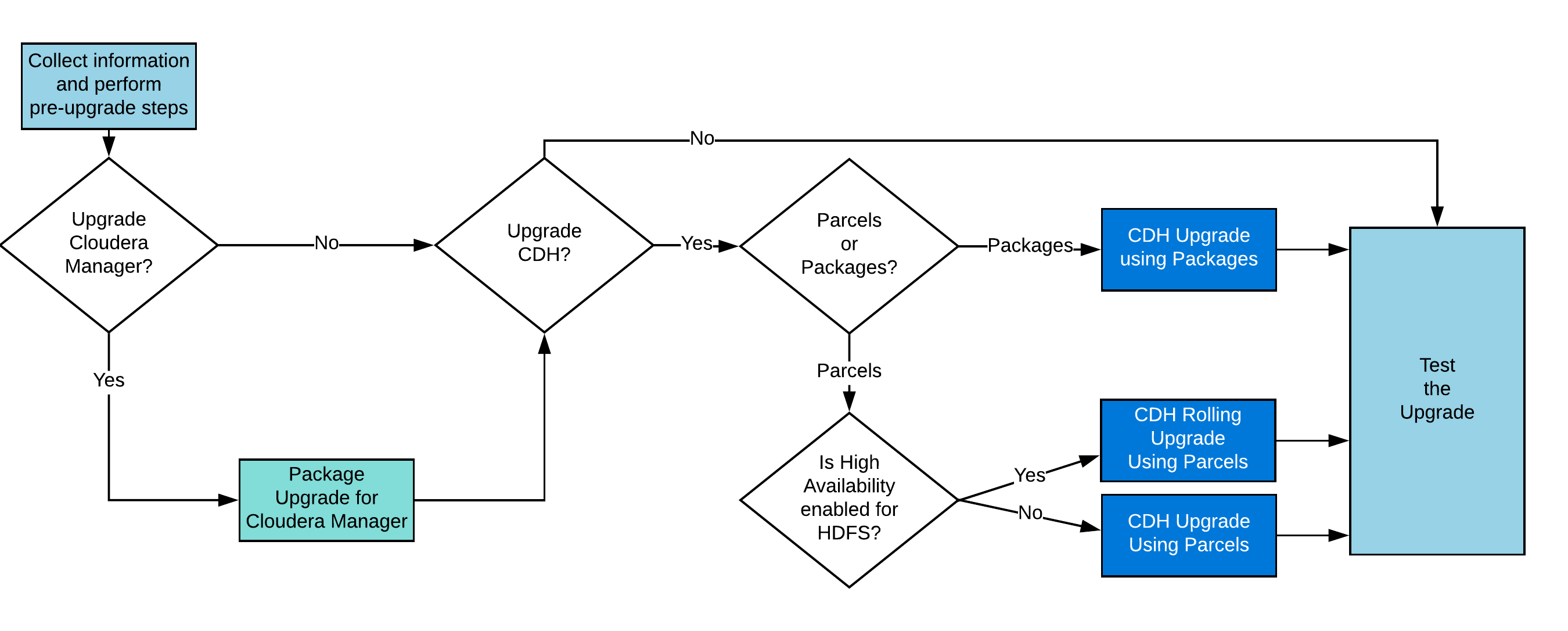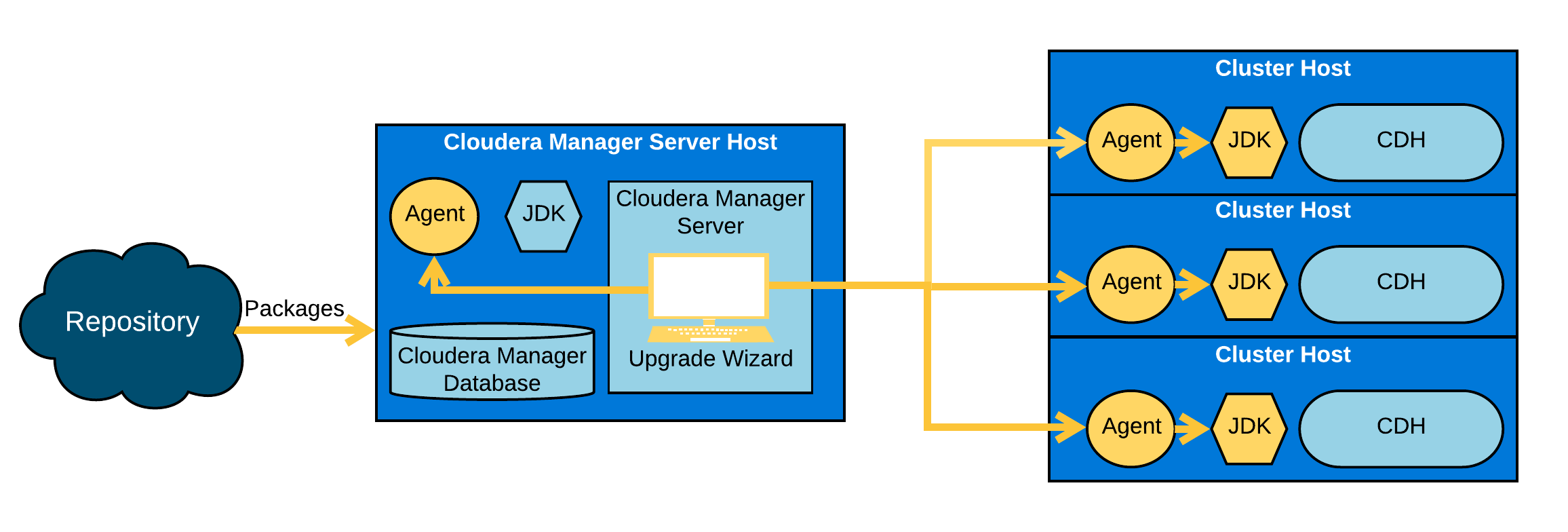Cloudera Upgrade Overview
This topic provides an overview of upgrade procedures for Cloudera Manager and CDH.
The procedures described here are for clusters managed by Cloudera Manager. For information about upgrading unmanaged CDH clusters (clusters that are not managed by Cloudera Manager), see Upgrading Unmanaged CDH Using the Command Line.
When upgrading Cloudera Manager, you use operating system packages. When upgrading CDH, you can use packages or parcels. You might also need to install a new version of the JDK. As of Cloudera Manager and CDH 6.0.0, only JDK 8 is supported. Cloudera Navigator is also upgraded when you upgrade Cloudera Manager.
You are not required to upgrade Cloudera Manager and CDH at the same time, but the versions of Cloudera Manager and CDH must be compatible. Cloudera Manager can manage clusters for the current and previous major versions of CDH and any equal or lower minor version of CDH.
You can choose from several options as you upgrade:

Continue reading:
Upgrading to the Cloudera Manager 6.0.0 Beta Release
You can upgrade your Cloudera Enterprise deployment to the beta release of 6.0.0. Please note the following:
- Do not use this beta software in a production environment. It is intended only for evaluation purposes.
- Rolling upgrades of CDH are not supported. Downtime is required.
- Rollback of your software and data is not supported.
- Upgrading to Cloudera Manager 6.0.0 beta requires the following:
- Cloudera Manager version 5.7 or higher
- All clusters managed by Cloudera Manager must be running CDH 5.7 or higher.
- JDK 1.8 must be installed on all cluster hosts, including hosts in clusters that are still running CDH 5.7 or higher.
- If you use the Solr Search service in your cluster, there are significant manual steps you must follow to upgrade. See Preparing Cloudera Search to Upgrade to CDH 6.
- Upgrades to version 6.0.0 require the Agents to be upgraded on all hosts, and the Agents must be restarted.
- Cloudera will not support upgrading from the Cloudera Enterprise 6.0.0 beta release to any generally available release of Cloudera Enterprise.
- The following services are no longer supported as of Enterprise 6.0.0:
- Accumulo
- Sqoop 2
- MapReduce 1
Assessing the Impact of an Upgrade
Plan for a sufficient maintenance window to perform an upgrade. Depending on which components you are upgrading, the number of hosts in your cluster, and the type of hardware, you might need up to a full day to upgrade your cluster. Before you begin the upgrade, you need to gather some information; these steps are also detailed in the Cloudera Manager and CDH upgrade procedures.
Before upgrading, consult the release notes for Cloudera Manager and CDH to learn about API changes, deprecated features, new features, and incompatible changes. Also check the Cloudera Enterprise 6 Requirements and Supported Versions page to make sure that you are using a supported operating system, JDK, database, and other components.
- Major Upgrade from Cloudera Manager and CDH 5.x to 6.0.0
- Cloudera supports upgrading your cluster from Cloudera Manager 5.7 and higher to Cloudera Manager 6.x and from CDH 5.7 or higher to CDH 6.x: A major upgrade typically has the following
characteristics:
- Large changes to functionality and update of Hadoop to a more recent version
- Incompatible changes in data formats
- Significant changes and additions to the user interface in Cloudera Manager
- Database schema changes for Cloudera Manager that are automatically handled by the upgrade process
- Significant down time for the cluster is required.
- Client configurations are redeployed.
- Minor Upgrades
- Minor upgrades upgrade your software to a higher minor version of a major release—for example from version 6.0.0 to version 6.0.1—and typically include the following:
- New functionality
- Bug fixes
- Potential database schema changes for Cloudera Manager that are handled automatically
- Maintenance Upgrades
- Maintenance upgrades are used only to fix critical bugs or address security issues. No new functionality or incompatible changes are introduced.
Overview of Upgrading Cloudera Manager

- Upgrade the Cloudera Manager server software on the Cloudera Manager host using operating system package commands from the command line (for example, yum on RHEL systems). Cloudera Manager automates much of this process and is recommend for upgrading and managing your CDH clusters.
- Upgrade the Cloudera Manager agent software on all cluster hosts. The Cloudera Manager upgrade wizard can upgrade the agent software (and, optionally, the JDK), or you can install the agent and JDK software manually. The CDH software is not upgraded during this process.
To upgrade Cloudera Manager, see Upgrading Cloudera Manager.
Overview of Upgrading CDH


(Also applies to rolling upgrades.)
Upgrading CDH using parcels is the preferred method because parcels are managed by Cloudera Manager, which automatically downloads, distributes, and activates the correct versions of the software. There are two types of parcel upgrades:- Parcels – Requires you to restart the cluster to complete the upgrade.

Upgrading CDH using packages requires you to download updated packages and manually run package upgrade commands on the Cloudera Manager server and all cluster hosts.
See Upgrading CDH and Managed Services Using Cloudera Manager
Overview of Upgrading Cloudera Navigator Components
Cloudera Navigator Metadata and Audit servers are automatically upgraded when you upgrade Cloudera Manager. You can also optionally upgrade other Cloudera Navigator components such as Cloudera Navigator Key Trustee Server, Cloudera Navigator Key HSM, and Cloudera Navigator Encrypt. You do not have to upgrade these components along with Cloudera Manager or CDH upgrades.
| << Embedded PostgreSQL Database | ©2016 Cloudera, Inc. All rights reserved | Upgrading Cloudera Manager >> |
| Terms and Conditions Privacy Policy |